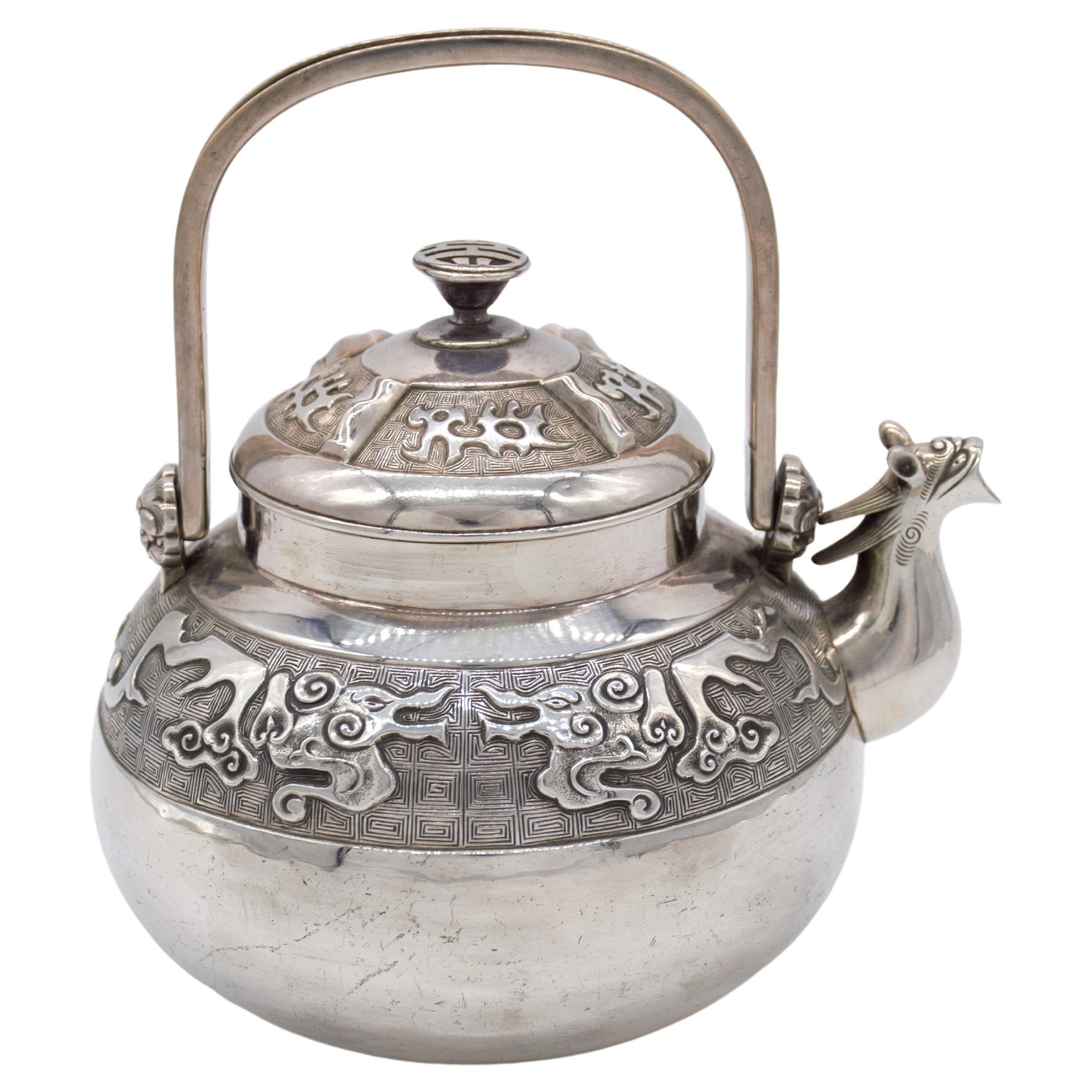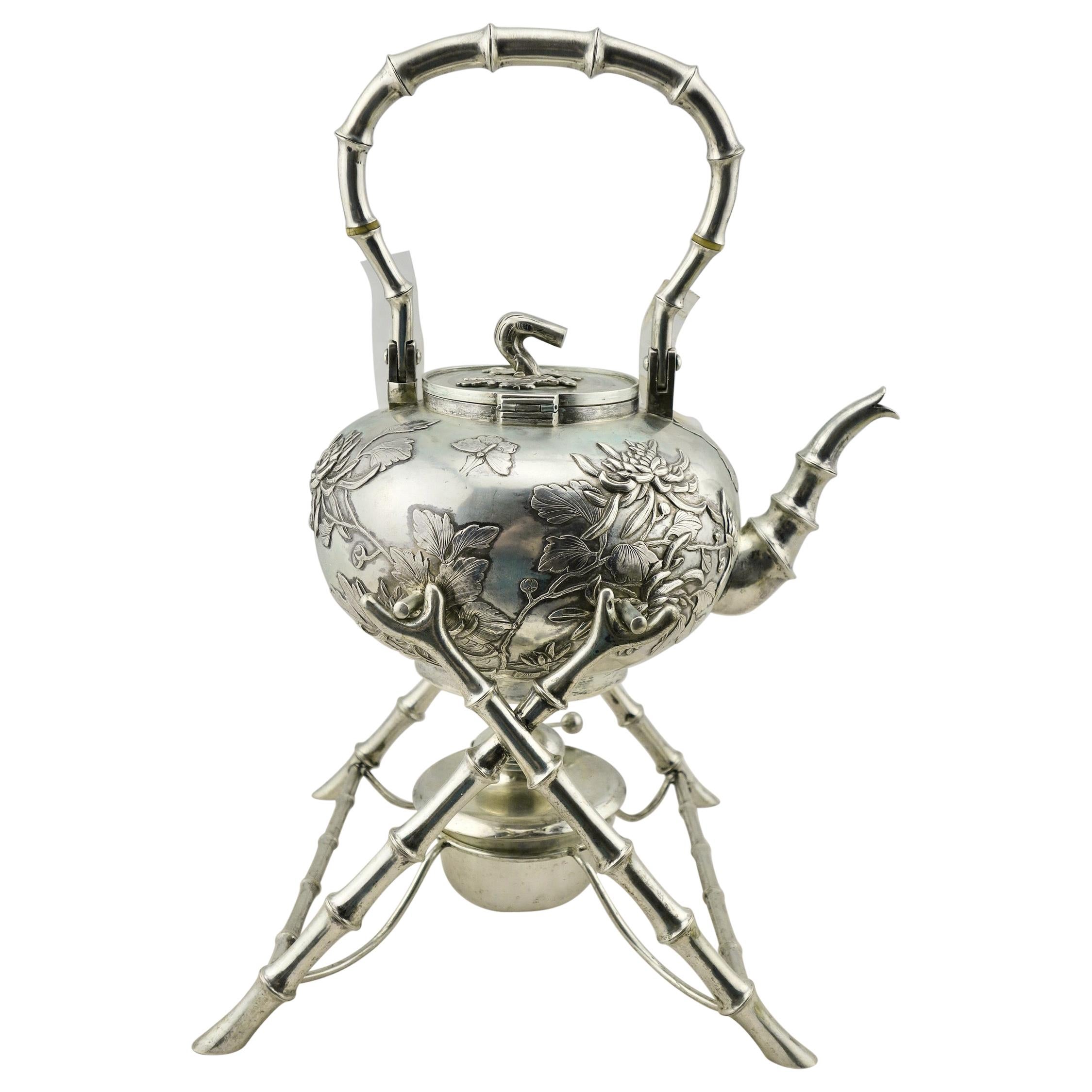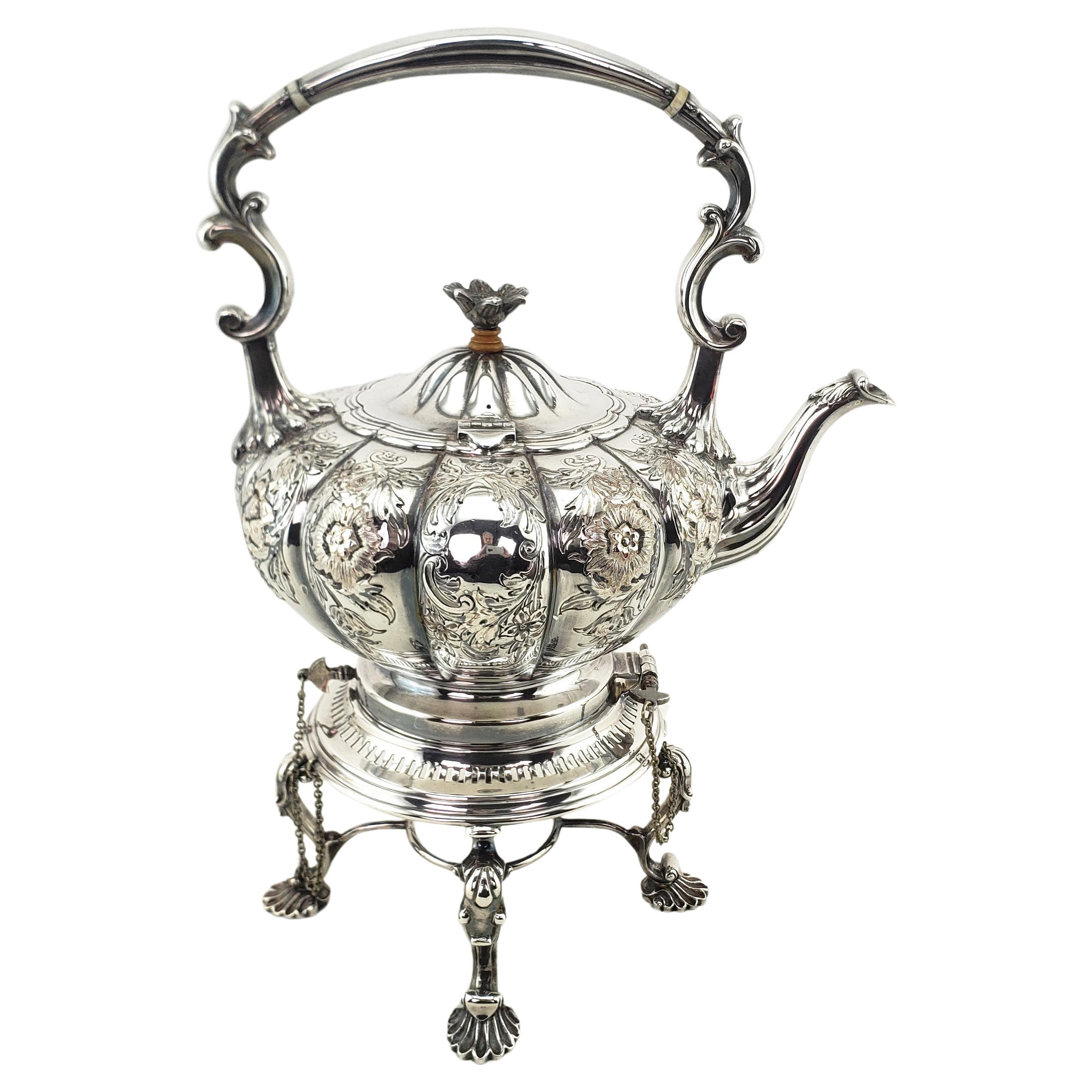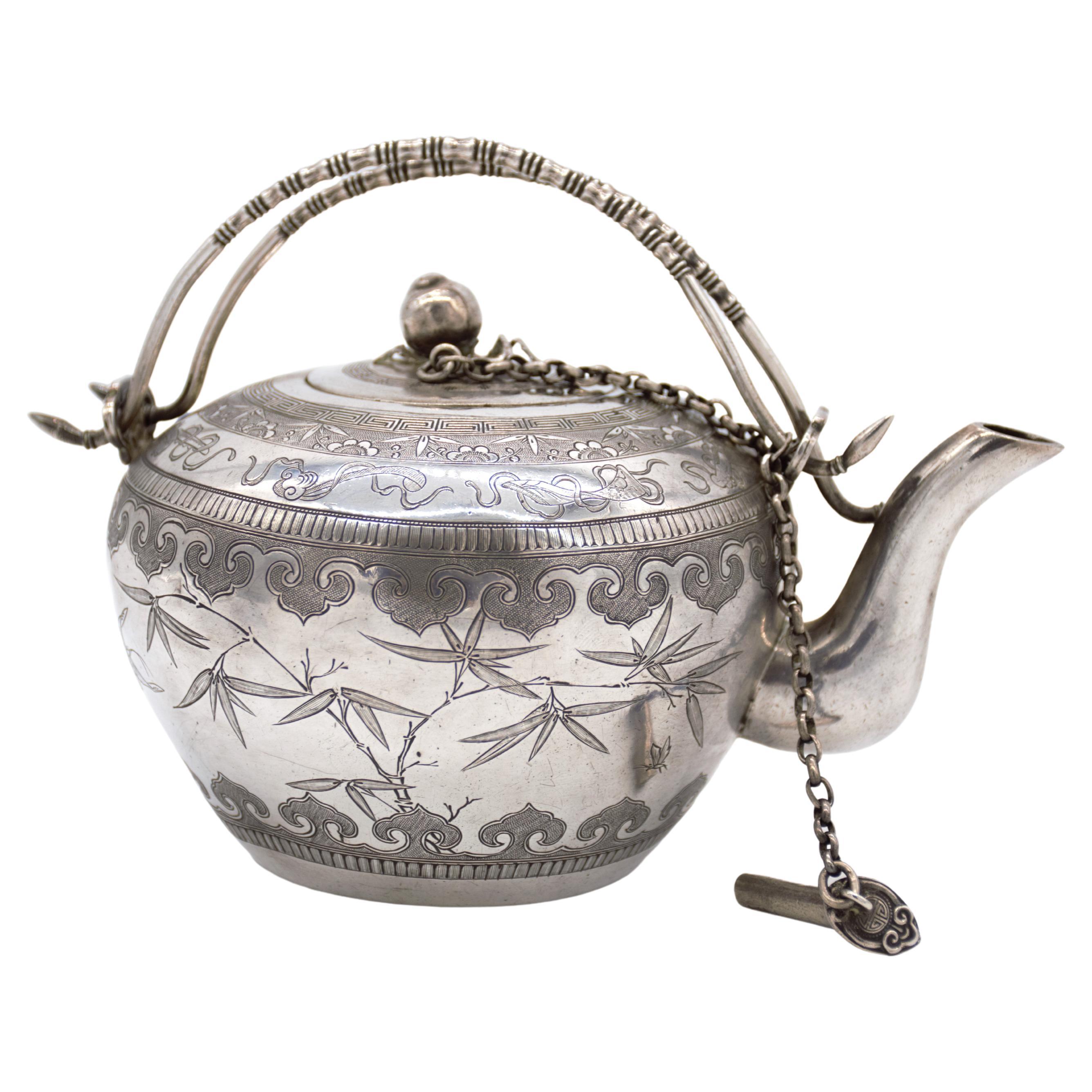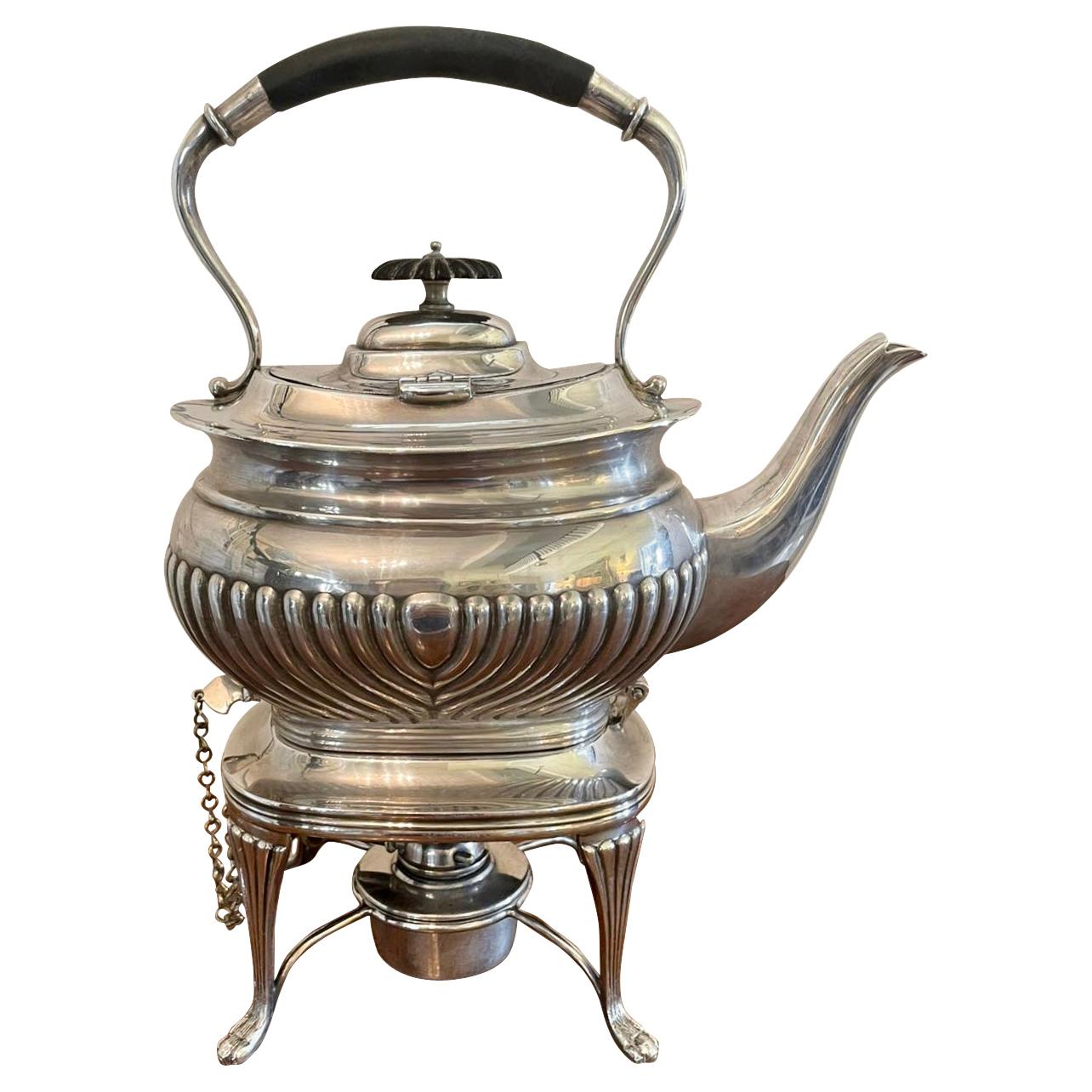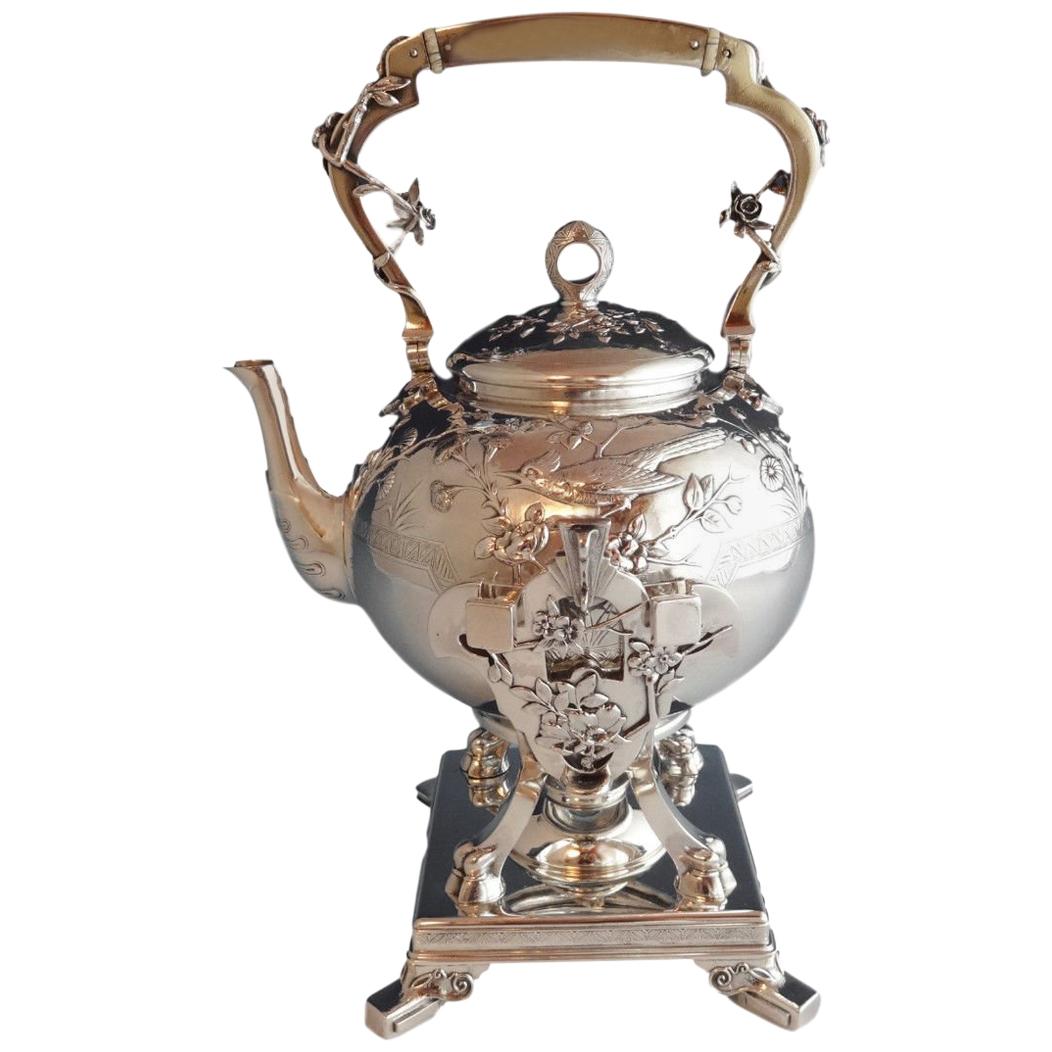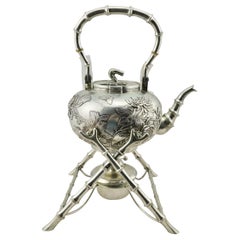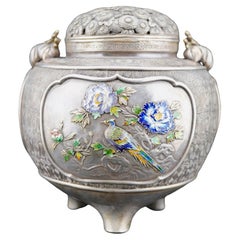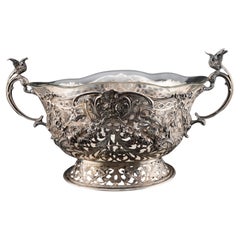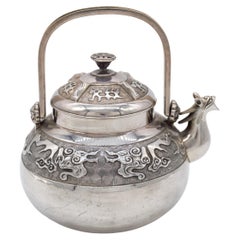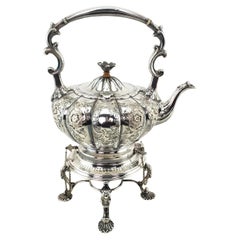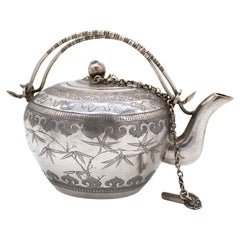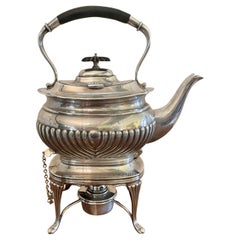Items Similar to Japanese Silver Meiji Period Massive Repousse Kettle on the Stand by Konoike.
Want more images or videos?
Request additional images or videos from the seller
1 of 11
Japanese Silver Meiji Period Massive Repousse Kettle on the Stand by Konoike.
$8,600
£6,486.62
€7,492.11
CA$12,049.19
A$13,398.01
CHF 7,014.10
MX$163,659.20
NOK 88,139.08
SEK 82,912.47
DKK 55,928.11
About the Item
Japanese Meiji silver kettle heavily hand chased in repousse irises. Applied cast elements around the handle. Comes with a custom wooden stand, decorated with lingzi fungus. The kettle is marked
for pure silver, Konoike maker. Weight 2782 g or 89.7 t. oz. Is 13.5 inches to handle, 10 inches to finial, 11 inches spout to back, 9 inches wide. The stand is 4 inches tall by 10 inches in diameter.
- Creator:Konoike (Maker)
- Dimensions:Height: 13.5 in (34.29 cm)Width: 11 in (27.94 cm)Depth: 9 in (22.86 cm)
- Style:Meiji (Of the Period)
- Materials and Techniques:
- Place of Origin:
- Period:
- Date of Manufacture:1890
- Condition:Wear consistent with age and use.
- Seller Location:Sarasota, FL
- Reference Number:1stDibs: LU5430242147212
About the Seller
5.0
Vetted Professional Seller
Every seller passes strict standards for authenticity and reliability
Established in 1990
1stDibs seller since 2020
26 sales on 1stDibs
Typical response time: 2 hours
- ShippingRetrieving quote...Shipping from: Sarasota, FL
- Return Policy
Authenticity Guarantee
In the unlikely event there’s an issue with an item’s authenticity, contact us within 1 year for a full refund. DetailsMoney-Back Guarantee
If your item is not as described, is damaged in transit, or does not arrive, contact us within 7 days for a full refund. Details24-Hour Cancellation
You have a 24-hour grace period in which to reconsider your purchase, with no questions asked.Vetted Professional Sellers
Our world-class sellers must adhere to strict standards for service and quality, maintaining the integrity of our listings.Price-Match Guarantee
If you find that a seller listed the same item for a lower price elsewhere, we’ll match it.Trusted Global Delivery
Our best-in-class carrier network provides specialized shipping options worldwide, including custom delivery.More From This Seller
View AllChinese Export Silver Teapot or Kettle on a Stand by Leeching, circa 1900
By Leeching
Located in Sarasota, FL
Chinese export silver teapot or kettle on a stand decorated with butterflies by Leeching.. The surface of the teapot has chased and applie...
Category
Early 20th Century Chinese Other Urns
Materials
Silver
Japanese Silver Enamel Incese Burner (Koro) Meiji Period
By Sanju Saku
Located in Sarasota, FL
Japanese silver and enamel Incense Burner (Koro) Meiji era (1868-1912), late 19th century. The koro is set on tripod feet, The body decorated with three panels of birds and flowers w...
Category
Antique 1890s Japanese Metalwork
Materials
Silver
Chinese Export Silver Bamboo Pattern Tea Service, circa 1880s
By Cumwo
Located in Sarasota, FL
Chinese export bamboo pattern silver 5-piece tea service, circa 1860-1880. The teapot, covered sugar, creamer and waste bowl marked "GW" for Gemwo maker of Hong Kong. The tray is mar...
Category
Antique 19th Century Chinese Other Tea Sets
Materials
Silver
German Silver Repousse and Open Work Centerpiece Basket with Glass insert 1890's
Located in Sarasota, FL
German 800 silver cast, repousse and openwork centerpiece basket with glass insert. Beautiful Baroque revival work. The basket is marked on the bottom with German silver marks. Silve...
Category
Antique Late 19th Century German Baroque Revival Decorative Bowls
Materials
Silver
Chinese Silver Repousse Dragon Handle Sauce Boat by Luen Wo
By Luen Wo
Located in Sarasota, FL
Chinese Export silver repousse sauce boat with dragon handles. Marked for Luen Wo.. Very fine decoration. 7 1/4" long, 4 " tall, 3 1/2", 7 oz weight.
Category
Antique 1890s Chinese Chinese Export Metalwork
Materials
Silver
Japanese Silver Repousse Iris Vase Meiji Period
By Samurai Shokai
Located in Sarasota, FL
Japanese silver repousse vase finely decorated with blown out iris flowers. It is of the Meiji period, circa 1890s. The vase is 5 1/4" tall and weighs 4....
Category
Antique 19th Century Japanese Metalwork
Materials
Silver
You May Also Like
Amazing Japanese silver teapot and cover, dragon spout Meiji period 19TH century
Located in Tel Aviv - Jaffa, IL
amazing rare archaistic style silver ewer or tea pot with cover, the design is Of archaistic style dragons on the main frieze and on the cover, this style came from ancient Chinese a...
Category
Antique 1890s Japanese Metalwork
Materials
Silver
$12,000
Free Shipping
Antique English Silver Plated Tipping Hot Water Kettle with Chased Floral Motif
Located in Hamilton, Ontario
This antique hot water tipping kettle is unsigned by a maker, but originated from England and dates to approximately 1900 and done in an Art Nouveau style. The kettle and stand...
Category
Antique Late 19th Century English Art Nouveau Sheffield and Silverplate
Materials
Silver Plate
Antique early 20th Chinese Exceptional Solid Silver Teapot, Wu Hua物華, Tianjin
Located in Tel Aviv - Jaffa, IL
Antique early 20th Century exceptionally rare Chinese solid silver teapot, of traditional round form, the body finely engraved in traditional Chinese style, suggesting this teapot was made for the Chinese market. The body engraved with bamboo and butterflies , the unusual handle imitating bamboo, the removable lid set with a peach finial (Peaches are the symbol of longevity). According to Daoist lore, the peaches of immortality grew in the garden of the Queen Mother of the West - Xi Wangmu.
the spout with a hedged cover in the shape of a lingzhi mushroom and a FU symbol of good furtune.
the top frieze is decorated with 8 Chinese symbols: a scroll, a Ruyi scepter, a qin, The Endless Knot, a pendant, an old book, a wrist rest, and two overlapping squares.
The teapot is very unusual, fine and exceptionally crisp. it is made of heavy Gauge silver and the attention to detail and design is simply outstanding.
"WU HUA...
Category
Early 20th Century Chinese Chinese Export Metalwork
Materials
Silver
Antique Edwardian Silver Plated Spirit Kettle on Stand
Located in Suffolk, GB
Antique Edwardian silver plated spirit kettle on stand with original shaped handle, lift up lid with original handle shaped spout. Pretty reeded...
Category
Early 20th Century English Tea Sets
Materials
Silver Plate
Japanese by Tiffany & Co. Sterling Kettle on Stand with Birds and Foliage
Located in Big Bend, WI
Japanese by Tiffany & Co. sterling kettle on stand with hand chased birds and applied foliage as presented in the Magnificent Tiffany book by John Lori...
Category
Antique Late 19th Century American Sterling Silver
Materials
Sterling Silver
Antique George II Georgian Silver Kettle on Stand London 1745 Teapot
By William Grundy
Located in London, GB
An excellent George II Georgian Solid Silver Kettle on Stand. The Tea Pot has an ornate chased design including floral, foliate and scroll patterning, and each side has a shaped cartouche with an engraved crest in it. The Teapot has a hinged domed lid with an impressive finial, and a substantial scroll shaped swing handle with a shaped wooden section. The Tea Kettle stands...
Category
Antique 18th Century English George II Tea Sets
Materials
Sterling Silver
$10,759 Sale Price
20% Off
Free Shipping
More Ways To Browse
Antique Chasing Hammer
Japanese Iris
Japanese Kettle
Antique Russian Spoons
Antique Silver Candy Dish
Antique Silver Chest Antiques
Antique Toast Rack
Enameled Sterling Silver Spoon Set
Georg Jensen Continental
Georg Jensen Pot
George Barnard
Gorham Aesthetic
Grande Baroque Wallace
Ice Cream Scoops
Irish Silver Table
Italian Sterling Silver Tea Set
Puiforcat Hermes
Queen Elizabeth Sterling Silver
